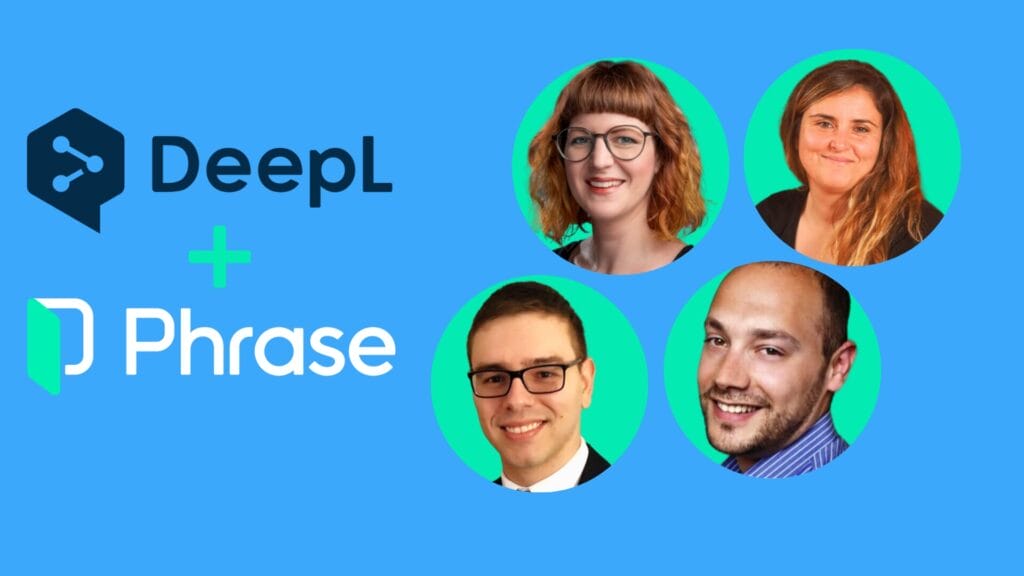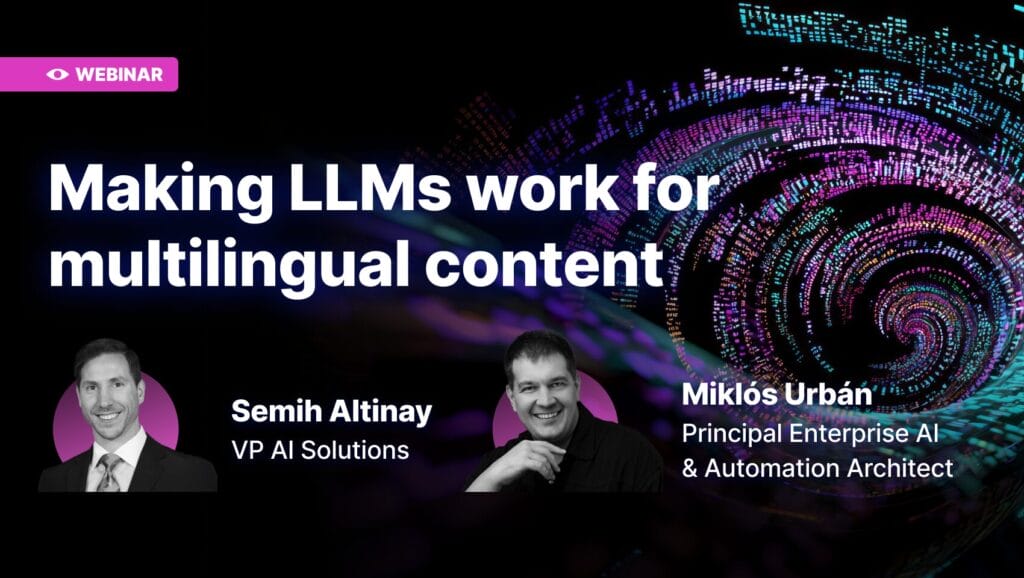For years, the world of enterprise translation automation followed a predictable, evolutionary path. The shift from Statistical to Neural Machine Translation (NMT) was a significant leap, bringing unprecedented fluency and accuracy.
But the past two years have triggered a revolution. The proliferation of Large Language Models (LLMs) hasn’t just improved translation; it has fundamentally fractured the landscape, presenting senior enterprise localization managers with a dizzying array of new models, workflows, and strategic questions.
The comfortable, one-size-fits-all approach of deploying a single, custom-trained NMT engine, embedded within a familiar MTPE workflow, is no longer sufficient.
Today, navigating the options, from foundational LLMs to document-level generative workflows, requires a new level of strategic agility.
The key takeaway for any localization leader in this space is clear: there is no single “best” solution. The optimal approach is dynamic, and the risk of falling behind by clinging to outdated strategies is very real and very consequential.
This article surveys the primary options available today, offering a framework for decision-makers to contrast these new approaches and build a flexible, future-proof translation automation strategy.
A new generation of models that go beyond fluency
The first and most obvious shift is the move from NMT to LLM-based translation models. While NMT models are marvels of pattern recognition, trained specifically on bilingual text, LLMs are fundamentally different.
Trained on vast, multilingual and multimodal datasets, they possess a deeper “understanding” of context, nuance, and intent.
This leads to several key differentiators:
- Vastly superior contextual awareness: NMT models operate with a limited view, often translating sentence by sentence. LLMs can ingest and process entire documents, maintaining consistency in brand-defining terminology formality and style, and narrative voice from start to finish.
- Built-in reasoning: LLMs can follow complex instructions embedded in a prompt, allowing for on-the-fly adjustments to tone, style, and formality in a way NMT simply cannot.
- Beyond literal translation: LLMs excel at “transcreation,” adapting marketing slogans or creative copy in a way that resonates culturally, moving beyond a literal word-for-word rendering. This is ground-breaking for use-cases that require such creativity, but provides little or no value for highly technical content such as documentation.
While the raw quality of a top-tier NMT engine can still be excellent, the inherent architectural advantages of LLMs are redefining what we consider a “high-quality” machine translation (see my previous article for some deeper perspectives on this changing perspective on quality).
The evolution of adaptation: from static training to dynamic context
The growing importance of enterprise-specific adaptation is not new. For years, the gold standard has been to fine-tune a baseline NMT model on an enterprise’s Translation Memories (TMs) and termbases. This process, known as static adaptation, creates a custom engine that learns a company’s specific terminology and linguistic style.
While effective, this approach has many drawbacks: it’s resource-intensive, time-consuming, and the resulting model is static. Itdoesn’t learn or adapt until it’s retrained.
LLMs have introduced a far more nimble paradigm: dynamic, on-the-fly adaptation. Using techniques like In-context Learning (ICL) and Retrieval-Augmented Generation (RAG), LLMs can be given real-time access to your content archive (whole documents), TMs and terminology databases at the moment of translation. Through detailed and carefully crafted prompts and “few-shot” learning (providing a few high-quality examples), the model can adapt its output instantly.
This shift is profound. Instead of a months-long training process, you can achieve deep customization in milliseconds. It allows for adaptation to be far more granular and targeted. You can adjust instructions for different audiences, content types, or even specific campaigns without needing a separate model for each. Solutions like Phrase Next GenMT are at the forefront of this evolution, harnessing the power of LLMs to leverage existing linguistic assets for this powerful, real-time adaptation.
A tale of two workflows: segmented vs. holistic
This new technological reality forces a critical evaluation of the traditional translation workflow. For two decades, the process has been granular and segment-based:
- A segment is checked against a Translation Memory
- If there’s no high-fuzzy match, it’s sent to an MT engine
- A human linguist performs post-editing (MTPE)
- A final human review ensures consistency and context-aware quality
This assembly-line approach is well-understood and effective for certain content types, like user interface strings or structured technical documentation. Especially in scenarios where segment-level in-context full matches from the TM dominate. However, LLMs unlock a completely different, holistic workflow.
In this model, an entire document is provided to an LLM with a detailed prompt outlining style, tone, terminology, and target audience.
The LLM reasons about the translation task given this guidance and then generates a complete, contextually-aware translation in a single pass. Post-editing is no longer about fixing segment-level errors but about a higher-level review of the entire document’s flow and consistency.
Furthermore, another LLM (also known as an “LLM-as-a-judge”) can be used to perform an initial quality assessment or even automatically further adapt the final document to ensure it meets all specified criteria.
Making the right choice: A framework for modern localization
So, which path is right for you? The answer depends entirely on the content. A strategic localization leader must map their content types and use cases to the optimal workflow. Here are the key factors to consider:
- Content type: For highly repetitive, structured content (UI strings, knowledge base articles), the traditional segment-based workflow remains highly efficient. For long-form, creative content where narrative consistency is paramount (marketing blogs, e-books, legal documents), the holistic, document-level approach is often superior.
- Quality and risk: What is the cost of an error? For high-risk, customer-facing content, a more human-in-the-loop, rigorous process is essential. For internal, low-risk content, a fully automated, holistic LLM workflow might be perfectly acceptable and incredibly efficient. The key is to have a flexible system that allows you to dial the level of human oversight up or down based foremost on risk, and considering cost and speed as important additional factors.
- Ownership and expertise: Who makes these critical decisions? Is it the enterprise localization manager? Or perhaps a solution architect at a partner LSI/LSP? Choosing the right model and workflow requires a deep understanding of both the technology and the enterprise’s content strategy.
This responsibility must be assigned to expert teams who can evaluate the trade-offs. The strategic options are also expanding: - Do you train your own NMT engines?
- Leverage a sophisticated platform that provides access to multiple underlying models?
- Or go a step further and develop a proprietary, enterprise-specific LLM to handle content generation and translation?
Increasingly often, the answer will not be a single one of these, but all of the above.
Thriving in an era of constant change
The explosion of options in translation automation is both a challenge and an immense opportunity. Content localization leaders who embrace this complexity and build a flexible, adaptable strategy will gain a significant competitive advantage. The era of a single, monolithic solution is over.
The future of localization is not about choosing one engine or one workflow. It is about having a central platform that provides the flexibility to choose the right tool for the right job, every time.
A language technology platform like the AI-led Phrase Platform is designed for this new reality, supporting everything from traditional TEP workflows with custom NMT to dynamic, on-the-fly adaptation with the latest LLM-based technology.
By embracing a proactive and adaptable approach, you can harness the full power of this technological revolution, ensuring your global content is not just translated, but is truly effective, engaging, and fit-for-purpose today, and tomorrow.
Phrase AI Solutions
The future of intelligent localization
Smarter translation. Higher quality. Greater scale





